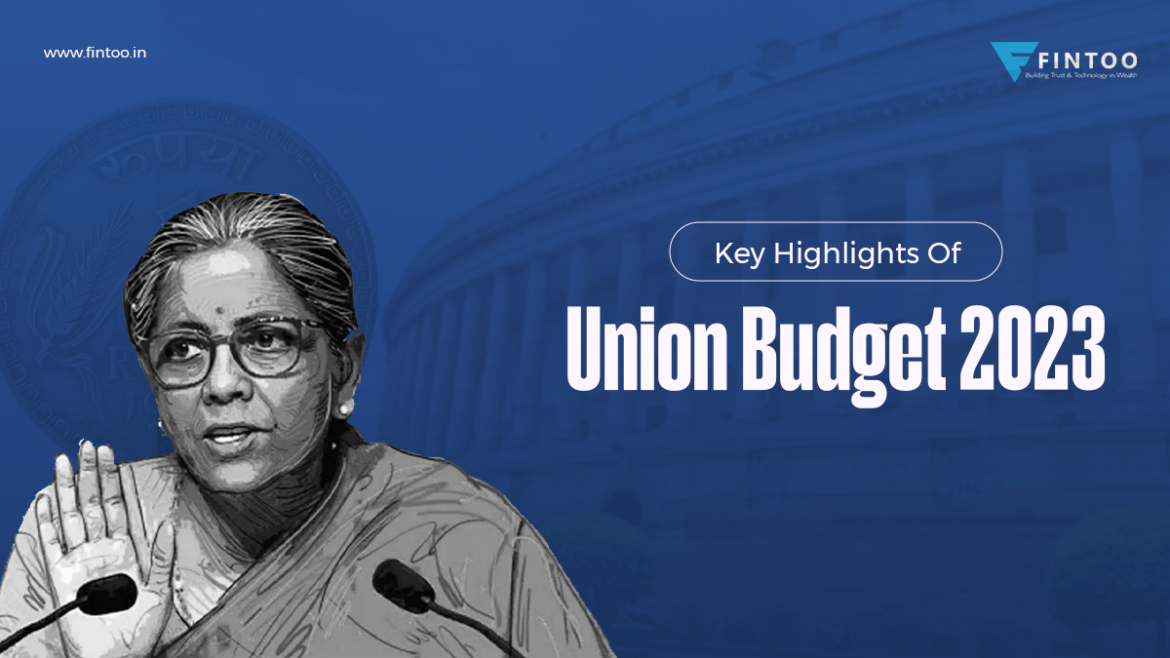

On February 1st, 2023, Nirmala Sitharaman, the Finance Minister, unveiled the Union Budget 2023. The budget, which took into account the government’s future plans and benefits for taxpayers, appears to be in line with expectations. From the highly anticipated tax relief for the salaried class to the impact on the insurance industry, here are the major highlights of the Union Budget 2023:
Capital Gain Exemption u/s Sections 54 and 54F:
According to sections 54 and 54F of the Income Tax Act, 1961, individuals and Hindu Undivided Families (HUFs) can claim a deduction on gains from the sale of a house property or other investments by reinvesting the proceeds in another house property, without any cap on the amount.
As per the current budget proposal, from April 1st, 2023, if the investment in a new house property exceeds 10 crores, the deduction will be capped at Rs. 10 crores. To summarize, individuals and HUFs can now avail of a maximum deduction of Rs. 10 crores by investing in new house property.
This change in the budget proposal is likely to affect ultra-high-net-worth individuals who are required to pay long-term capital gains tax on the sale of high-value house properties. However, the new cap of Rs. 10 crores on the deduction amount is unlikely to pose a significant challenge, as individuals and HUFs can still claim a deduction up to that limit.
Impact On The Insurance Sector:
One of the significant setbacks outlined in the finance bill pertains to the taxation of the maturity proceeds from a life insurance policy.
As per the budget 2023, the maturity proceeds of all life insurance policies that are issued after 1st April 2023 and have an annual premium of more than Rs. 5 Lakhs will now be taxable. One should note that if an individual has more than one life insurance policy issued on or after 1st April 2023, and also if the aggregate amount of premium of such policies exceeds Rs. 5 lakhs, then the maturity amount will be taxable.
According to the Union Budget 2023, the maturity proceeds from all life insurance policies issued after April 1st, 2023, and with an annual premium exceeding Rs. 5 Lakhs will now be subject to taxation. It’s important to note that if an individual has multiple life insurance policies issued after April 1st, 2023, and the total premium of these policies exceeds Rs. 5 lakhs, the maturity amount will be taxable.
MLD Is No More The Favourite Investment Option:
Prior to the budget proposal, Market Linked Debentures (MLDs) were considered a favorable investment option in terms of taxes. The income generated from MLDs with a maturity period of over 12 months was considered long-term capital gains. It was taxed at either 20% with indexation or 10% without indexation. This resulted in MLDs being a popular investment instrument due to the low tax on gains.
However, in her budget speech, Honorable Finance Minister Nirmala Sitharaman announced that the income from MLDs will now be taxed as short-term capital gains, effective April 1st, 2024, to provide equality in treatment according to the new section 50AA of the Income Tax Act, 1962.
Additionally, it is worth noting that no deductions will be permitted for the Short-Term Transaction Tax (STT) paid on these MLDs. With the current budget proposals, short-term capital gains tax will be levied at 15% if the MLD is STT paid, and will be taxed according to the regular income tax slab if it is not STT paid. As most MLDs are not STT paid, the gains from the sale of MLDs will now be included in your income and taxed at higher applicable rates.
Railways Get Big Chunk In Budget 2023-24:
The 2023 Union Budget placed significant emphasis on the Railways sector, as the Finance Minister announced a record allocation of Rs 2.40 lakh crore, which is nine times higher than the allocation in 2013-14. The Finance Minister stated that the focus this year would be on completing ongoing projects and improving infrastructure. The goal is to bring high-speed trains into operation as soon as possible.
The allocated funds will be used for laying new tracks, adding more semi-high-speed Vande Bharat trains, introducing hydrogen-powered trains, and implementing the Ahmedabad-Mumbai bullet train project. The Indian Railways is working towards introducing 75 Vande Bharat trains by August 2023. A tender for the production of 200 Vande Bharat sleeper trains is expected to be awarded soon. The 2023 Economic Survey predicts that passenger traffic on the Indian Railways will experience robust growth.
The Survey states that improved mobility across the country and the demand for faster trains will drive growth in passenger traffic in the years to come. Railways have always been a priority for successive governments, and the railway system is now viewed as a facilitator and is expected to become a driving force for national growth.
Mahila Samman Savings Certificate:
The budget also introduced the Mahila Samman Savings Certificate, a new scheme for female investors, to commemorate the Azadi Ka Amrit Mahotsav.
This is a one-time small savings scheme that will be available for a two-year period ending March 2025. Women and girls can invest up to ₹2 lakhs for a tenor of 2 years, with an attractive interest rate of 7.5% per annum and the option of partial withdrawals.
The introduction of this women-oriented scheme will encourage female investors to start saving for their short-term financial goals and needs. Compared to other small savings schemes such as the Sukanya Samriddhi Yojna, which has a maximum investment limit of ₹1.5 lakhs per financial year and a long lock-in period of 21 years, the Mahila Samman Savings Certificate provides an opportunity to invest up to ₹2 lakhs for a 2-year tenure, making it a more favorable investment option for women.
New Tax Regime Increase in Disposable Income:
The government made efforts to encourage taxpayers to adopt the new tax regime. The finance minister announced several incentives to make the new tax regime more appealing, such as an increase in the basic exemption limit to ₹3 lakhs, an increase in the rebate limit to ₹25,000 from ₹12,500, a reduction in tax rates, and the introduction of a standard deduction. These measures were aimed at making the new tax regime more attractive and accessible to taxpayers.
Furthermore, the new tax regime has been designated as the default tax regime, with the option for taxpayers to switch back to the old regime if they prefer. This change was made to simplify the tax filing process and encourage more taxpayers to adopt the new, more favorable regime.
This change in tax policy is expected to benefit many taxpayers, particularly those with taxable income in the lower to mid-range. The increase in the basic exemption limit to Rs. 3 lakhs, combined with the increased rebate limit of Rs. 25,000 and reduced tax rates, means that individuals with taxable income of up to Rs. 7 lakhs will no longer be required to pay any tax. This represents a significant increase in disposable income for these individuals and should provide a boost to consumer spending and overall economic growth. Overall, these changes in the tax regime are aimed at simplifying the tax system, reducing the tax burden on citizens, and promoting economic growth.
It is important to take into consideration the impact of the changes made in the budget 2023 on your personal finances. Taxpayers who choose the old tax regime will not see any change in their disposable income, while those who opt for the new tax regime can potentially save a significant amount of tax. It is advisable to seek guidance from a tax advisor to determine which tax regime will be more beneficial for you based on your income levels and other financial circumstances. It may be beneficial to review and revise your tax planning strategies to ensure that you are making the most of the available tax savings options.
Infrastructure:
The Union Budget 2023, as outlined by the Finance Minister, has identified Infrastructure and Investments as one of its seven main priorities. For the third consecutive year, the capital investment outlay has seen a significant hike of 33%, reaching a total of Rs 10 lakh crores, equivalent to 3.3% of the country’s GDP.
The provisions of the Budget aim to enhance the government’s efforts to develop the infrastructure sector through the National Infrastructure Pipeline (NIP) along with other programs like “Make in India” and the production-linked incentives (PLI) scheme. The sectors of roads and railways have received substantial capital outlays in recent budgets, contributing to the government’s increased focus on capital expenditures.
The substantial increase in allocation is perceived as a strategy to generate employment opportunities and stimulate capital expenditures, thereby creating a positive impact on the economy through the interplay of investment and job creation, thereby forming a virtuous cycle.
Sabka Sath Sabka Vikas:
With a goal of providing a major boost to the infrastructure sector and reaching remote areas, the Honorable Finance Minister Nirmala Sitharaman announced a 50-year, interest-free loan for the states to use towards capital expenditures during the 2023-24 fiscal year.
This initiative will energize infrastructure development and enhance collaboration between the Central Government, State Governments, and Local Bodies. However, it should be noted that the utilization of this interest-free loan is subject to the following conditions;
1. State Govt. has to utilize it to increase their actual capital expenditure
2. Part of the money should be used or linked to the new govt. initiatives announced in this budget like;
- Scrapping old government vehicles
- Urban planning reforms and actions
- Financing reforms in urban local bodies to make them creditworthy for municipal bonds
- Housing for police personnel above or as part of police stations
- Constructing Unity Malls
- Children and adolescents’ libraries and digital infrastructure, and. The state share of capital expenditure of central schemes
3. This fund should be utilized within 2023-24
This measure will empower the State Governments, particularly in cases where the Central and State Governments work in partnership. It is expected to have a significant impact on states such as Uttar Pradesh, Madhya Pradesh, North East, and others where the Central Government has a presence at the state level.
Considering the upcoming Lok Sabha elections next year, the government has planned to make significant investments at the local level. However, the challenge lies in efficiently utilizing and executing the capital expenditures projects within the year, as most of these projects are of a long-term nature. As a result, we can expect to see a multitude of new projects, both at the central and state level, in the lead-up to the elections.
By taking this approach, the government is also attempting to manage the country’s fiscal situation. The states have been granted a fiscal deficit limit of 3.5 percent of GDP, with 0.5 percent of this amount tied to reforms in the power sector.
From the perspectives of the nation, states, and individuals, it is believed that the 2023 budget has the potential to guide India toward a path of growth and development.
Disclaimer: The views expressed in the blog are purely based on our research and personal opinion. Although we do not condone misinformation, we do not intend to be regarded as a source of advice or guarantee. Kindly consult an expert before making any decision based on the insights we have provided.
Related Posts
Stay up-to-date with the latest information.


